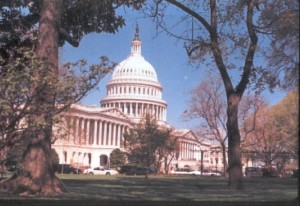The President’s proposed Fiscal Year (FY)17 budget once again proposes to reduce funding for APHIS and USDA Forest Service. These are the programs that protect our trees and forests; these are the programs that try to prevent introductions of tree-killing insects and disease pathogens, and to counter the damage they cause once introduced.

Congress is expected to act beginning this spring; we need Congress to enact adequate funding for these programs in FY17 – which begins in October.
I provide below the FY15 & FY16 funding levels and the President’s proposed FY17 level. I also suggest more appropriate funding levels for these programs.
Please contact your Representative and Senators by mid-March and ask him or her to support higher funding for these crucial programs. Your voice is particularly important if your Representative or Senator sits on either the Agriculture or Interior Appropriations subcommittees (listed below).
Fiscal Year Funding for Key Programs (funds are given in millions of dollars)
APHIS (I apologize – columns don’t line up!)
FY15 FY16 FY17 (Pres’ request) $needed
Plant Health (total) 305 314 288
Specialty crops 156 164 146 164
Tree & wood pests 54 54 46 54
The “Tree & wood pests” account funds all APHIS efforts to contain or eradicate the Asian longhorned beetle and emerald ash borer; much smaller programs targeting walnut twig beetle/thousand cankers disease, laurel wilt, and polyphagous shot hole borer [all described here as well as the agency’s involvement in firewood and other slow-the-spread campaign. Even at the $54 million funding level, APHIS is already ignoring many established pests … and its ability to respond to new introductions is severely restricted. With the continuing presence of damaging wood-borers in incoming crates and pallets (See earlier blogs discussing the wood packaging pathway posted in August, September, and October; and Chapter IV of Fading Forests III, now is not the time to cut funding for this program.
The “specialty crops” account includes a small amount of funding (in past years, approximately $5 million) to support APHIS’ program aimed at preventing spread of sudden oak death through movement of nursery stock. (For discussions of this risk see my earlier blogs from July and August and Chapter IV of Fading Forests III.
The budget justification notes that “cooperators who directly benefit from … activities [under the Tree and Wood Pests and Specialty Crop Pests programs] will need to increase contributions to achieve the same level of program operations. Even with the proposed decreases, APHIS will continue to pay between 47 percent and 80 percent of the costs of the programs. …” The Office of Management and Budget has long tried to reduce the federal share of pest containment costs. I counter: is it not appropriate that the agency with the legal responsibility for preventing and containing pest introductions bear the cost of responding when pests are introduced nevertheless?
Fiscal Year Funding for Key Programs (funds are given in millions of dollars)
USFS (I apologize – columns don’t line up!)
FY15 FY16 FY17 Pres’ request needed
Forest Health Protection (total)
104.57 99.6 92.06 100?
Federal lands 58.922 58.922 51.382
Coop lands 45.655 40.678 40.678 48
FHP funds the Forest Service’ assistance to federal partners (e.g., National Park Service) and non-federal entities (e.g., states, cities, private land managers) for management of forest pests – both native and alien species. The FY17 budget justification does not provide a breakdown of spending by species. The FY16 President’s request allocated only $12 million (13% of total funds) to specific projects targeting non-native insects or pathogens. More than $7 million of these funds went to just one species – European gypsy moth. Please advocate for a higher proportion to go to non-native pests.
Research (total) 296 291 291.982 300?
Forest Inventory 70 75 77 83
The USFS Research and Development program provides most of the funds for research to understand non-native pests’ pathways of introduction and spread and biological impacts. These funds also support most of the efforts to breed resistance into tree species and some of the work on other control methods, such as chemicals and biocontrol. The FY17 budget justification does not provide a breakdown of spending by species; the FY16 President’s request allocated only $5 M (less than 2% of total funds) to projects targeting non-native insects or pathogens. Please advocate for a higher proportion to go to non-native pests.
Members of key House & Senate Appropriations Subcommittees
Agriculture Appropriations Subcommittees (fund APHIS):
House: Aderholt (AL), Yoder (KS), Rooney (FL), Valadao (CA), Harris (MD), Young (IA); Farr (CA), DeLauro (CT), Bishop (GA), Pingree (ME)
Senate: Moran (KS), Blunt (MO), Cochran (MS), McConnell (KY), Collins (ME), Hoeven (ND), Daines (MT), Merkley (OR), Feinstein (CA), Tester (MT), Udall (NM), Leahy (VT), Baldwin (WI)
Interior Appropriations Subcommittees (fund USFS):
House: Calvert (CA), Simpson (ID), Cole (OK), Joyce (OH), Stewart (UT), Amodei (NV), Jenkins (WV); McCollum (MN), Pingree (MD), Kilmer (WA), Israel (NY)
Senate: Murkowski (AK), Alexander (TN), Cochran (MS), Blunt (MO), Hoeven (ND), McConnell (KY), Daines (MT), Cassidy (LA); Udall (NM), Feinstein (CA), Leahy (VT), Reed, Tester (MT), Merkley (OR)
Posted by Faith Campbell